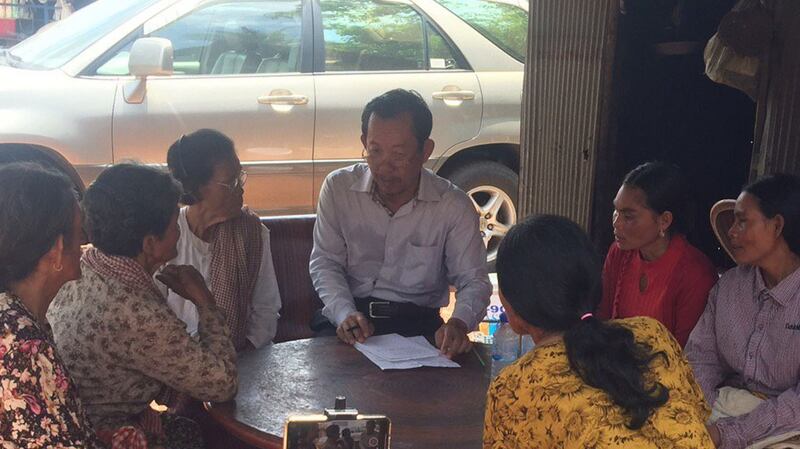Cambodia on Thursday distributed a newly drawn topographical map of the country’s shared border with Vietnam to local authorities and submitted it to the United Nations for recognition, despite ongoing allegations that the government has allowed Vietnam to encroach on Cambodian territory.
The border designation reflects one agreed to in a 1:25,000 scale map exchanged between Cambodia and Vietnam in a ceremony at the Moc Bai International Border Gate in southern Vietnam’s Tay Ninh province, on the border with Cambodia’s Svay Rieng province, on Aug. 1.
Speaking at Thursday’s distribution ceremony, Cambodian Defense Minister Tea Banh called the new map “historic” and of “significant importance” to the country.
“These maps are for public use—they are authentic,” he said.
“We didn’t have one in the past, but it is real now. We have demarcated the border according to the maps … I am very proud of it. This gives us a strong foundation to resolve our differences.”
Tea Banh said that anyone who criticizes the government’s handling of the border is an “extremist” and “will not be forgiven” for making false statements about Cambodia ceding land to its neighbor. He noted that Cambodia also shares a border with Laos and Thailand, but only the border with Vietnam receives negative attention from activists.
Unresolved border issues between Cambodia and Vietnam, former French colonies from the 1860s to 1954, have regularly inflamed nationalist sentiment. The disputed border has sparked incidents in the past, with the construction by Vietnam of military posts in contested areas quickly challenged by Cambodian authorities in Phnom Penh.
Activists in Cambodia say farmers are losing land because the government is demarcating the border based on a 1985 treaty signed during Vietnam’s 1979-89 occupation of the country following its ouster of the Khmer Rouge regime.
A joint communique signed by Cambodia and Vietnam in 1995 stipulates that neither side can make any changes to border markers or allow cross-border cultivation or settlement pending the resolution of outstanding border issues.
The dispute again came to the forefront with the July 31 arrest of union leader Rong Chhun for claiming the Cambodian government has allowed Vietnam to encroach on farmland along their shared border. The president of the Cambodian Confederation of Unions (CCU), was officially charged with “incitement to commit a felony or cause social unrest” the following day, prompting near-daily protests demanding his release.
Since then, two of Rong Chhun’s supporters from the civil society group Khmer Thavarak have been charged with crimes in connection to a protest calling for him to be freed, while Suong Sophorn, the president of the little-known opposition Khmer Win Party (KWP), was arrested and charged with “incitement” after visiting the border and making similar accusations.
Prime Minister Hun Sen on Aug. 15 told the public that the new map was published in Denmark, suggesting it was independently arbitrated, but said it had put Cambodia “at an advantage over Vietnam.”
However, Um Sam An, the border policy chief of the banned opposition Cambodia National Rescue Party (CNRP), suggested that the new map was unilaterally drawn by Hanoi and said it had caused Cambodia to cede at least 3,000 hectares (7,415 acres) of land to Vietnam.
“The government has handed over an illegal map and we have lost Cambodian land,” he told RFA, adding that he will continue to advocate for a redrawing of the border.
Um Sam An did not offer any evidence to support his claims but referred to the 1985 treaty as the reason for the land loss.

Border structures
Meanwhile, border activists called Thursday on the government to prevent Vietnamese authorities from building concrete structures near nondemarcated border areas in the Cambodian provinces of Takeo and Kandal, Kratie, Prey Veng, Svay Rieng, Tboung Khmum, Mondulkiri and Ratanakkiri.
They said that so far, the Vietnamese have built 27 permanent structures.
RFA was unable to reach Kandal Provincial Governor Kong Sophoan for comment about the structures on Thursday, but he recently told local media that he had made a formal request to stop building structures to his counterparts in Vietnam, which was refused. He said he would continue to call for an end to the construction.
Cambodia’s government has lodged diplomatic protests over the structures, but Vietnam has yet to respond.
Government spokesman Phay Siphan said Thursday he had not received reports of the construction from Kandal provincial authorities but added that he doubts the legitimacy of the claims.
“Hun Sen already talked with Vietnamese leaders and asked them not to build any structures in border areas that have not been demarcated,” he said. “We have already agreed on that principle.”
Cambodia Watchdog Council (CWC) President Men Nath urged the government to resolve the issues in Kandal province, adding that it is time for Cambodia to file a complaint against Vietnam with the International Court of Justice and the U.N. to find a resolution.
“The Vietnamese have violated international law and invaded Cambodia—this is our concern,” he said.
“We want Hun Sen to tell Vietnam to stop violating international law.”
A border activist named Mean Prumh Mony said Vietnam had also violated the charter of the Association of Southeast Asian Nations (ASEAN), of which both nations are members, and called for Cambodia to seek resolution of the issue through the regional and international community.
“Vietnam has threatened our territorial sovereignty,” he said. “We urge the government to file a complaint with the international court.”
The Vietnamese Embassy was not immediately available for comment on the dispute.
Reported by RFA's Khmer Service. Translated by Samean Yun. Written in English by Joshua Lipes.
